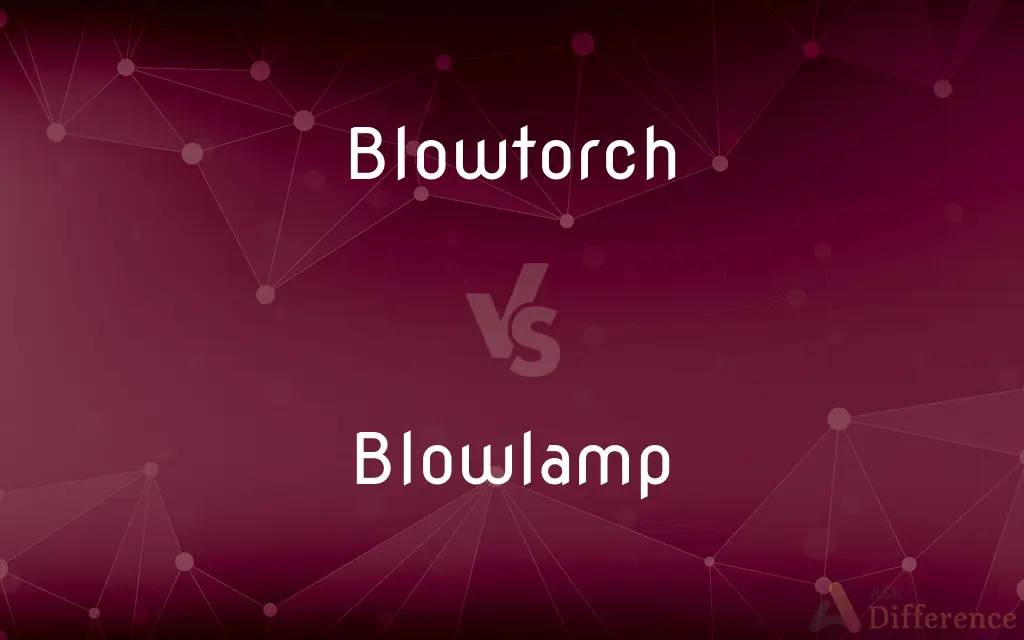Blowtorch vs. Blowlamp — What's the Difference?
Edited by Tayyaba Rehman — By Fiza Rafique — Updated on April 25, 2024
A blowtorch is a tool that produces a fine, high-temperature flame for metalworking, while a blowlamp is similar but traditionally uses different fuels and is often larger and less precise.

Difference Between Blowtorch and Blowlamp
Table of Contents
ADVERTISEMENT
Key Differences
A blowtorch generally refers to a small, handheld device that directs a precise, hot flame used primarily for metalworking, such as soldering and welding. It is typically fueled by propane or butane. On the other hand, a blowlamp, often considered an older or regional term, especially in the UK, refers to a similar tool but is usually larger and has a broader flame, and historically it was fueled by gasoline or kerosene.
Blowtorches are known for their portability and ease of use, making them suitable for detailed and precise work in both professional and hobbyist settings. Conversely, blowlamps, with their larger size and less controlled flame, are better suited for applications requiring more heat over a larger area, such as stripping paint or thawing frozen pipes.
In terms of temperature control, blowtorches offer more precision, allowing the user to adjust the flame size and intensity according to the specific needs of the task. Blowlamps, while adjustable, typically provide less fine control, making them less ideal for tasks requiring detailed heat application.
Blowtorches are commonly used in modern metalworking and DIY projects due to their convenience and efficiency. Blowlamps, while still used, are often seen as more traditional tools and are less common in typical consumer markets, often replaced by more modern devices.
Safety features are more advanced in contemporary blowtorches, which include safety locks and flame control options. Blowlamps, particularly older models, may lack these features and require more careful handling to avoid accidents.
ADVERTISEMENT
Comparison Chart
Size and Portability
Smaller, more portable
Larger, less portable
Fuel Type
Commonly propane or butane
Historically gasoline or kerosene
Flame Control
High precision for detailed tasks
Broader flame, less precise
Typical Use
Metalworking, soldering, detailed heating tasks
Larger scale heating, paint stripping
Safety Features
Modern safety features like locks and controls
Often lacks modern safety features
Compare with Definitions
Blowtorch
Portable gas torch used in culinary settings to caramelize sugar or sear meat.
The chef used a blowtorch to finish the crème brûlée.
Blowlamp
A lamp burning volatile fuel and using a blowpipe to direct the flame for heating materials.
The old blowlamp was still used for stripping paint from wood.
Blowtorch
A tool for applying flame and heat for various tasks such as soldering pipes.
The plumber carried a blowtorch in his toolkit for pipe repairs.
Blowlamp
A larger type of torch that produces a steady but less controlled flame.
They used a blowlamp to quickly thaw the frozen pipes.
Blowtorch
A tool used in various crafts for applying controlled heat.
He used a blowtorch to bend small pieces of copper for his art project.
Blowlamp
An older term for a device similar to a modern blowtorch, typically less refined.
His grandfather's blowlamp was a staple in his toolshed.
Blowtorch
A small burner used to emit a hot flame by combining a gas fuel with air, ideal for metalwork.
He used a blowtorch to weld the broken metal joints.
Blowlamp
A tool used for heating and melting substances in bulk.
The blowlamp was perfect for heating the large metal sheets.
Blowtorch
A handheld device used to generate precise flames.
She used a blowtorch to create her metal sculpture.
Blowlamp
A traditional tool often used in construction and repair for applying large amounts of heat.
The restoration project required a blowlamp to remove decades of paint.
Blowtorch
A blowtorch is a fuel-burning tool used for applying flame and heat to various applications, usually metalworking. Early blowtorches used liquid fuel, carried in a refillable reservoir attached to the lamp.
Blowlamp
A burner that burns a fuel in air to produce a hot flame; a blowtorch
Blowtorch
A portable burner for mixing gas and oxygen to produce a very hot flame, used for soldering, welding, glassblowing, and cooking certain foods, such as a brûlée.
Blowlamp
A burner that produces a hot flame.
Blowtorch
A tool which projects a controlled stream of a highly flammable gas over a spark in order to produce a controlled flame.
Blowlamp
A burner that mixes air and gas to produce a very hot flame
Blowtorch
A jet fighter.
Blowtorch
To apply a blowtorch to something.
Blowtorch
A burner that mixes air and gas to produce a very hot flame
Common Curiosities
Are blowtorches safer than blowlamps?
Modern blowtorches generally have more advanced safety features compared to traditional blowlamps.
Why might someone choose a blowlamp over a blowtorch?
For tasks requiring a larger, steady heat over a broad area, such as stripping paint or thawing pipes, a blowlamp might be more effective.
Can both tools be used for the same tasks?
While both can be used for heating and melting tasks, blowtorches are better for precise work, and blowlamps are suited for larger area applications.
How do the flame controls compare between the two?
Blowtorches generally offer more precise control over flame size and intensity, whereas blowlamps provide broader and less precise flame control.
Are blowtorches and blowlamps used in professional settings?
Both can be found in professional settings, but blowtorches are more prevalent due to their versatility and safety features.
Are there different sizes of blowtorches and blowlamps?
Yes, both tools come in various sizes, but blowtorches tend to be consistently smaller and more portable.
How do I maintain these tools?
Regular cleaning, proper storage, and checking for leaks are essential for both tools' maintenance.
What is the main difference between a blowtorch and a blowlamp?
A blowtorch is typically smaller, more precise, and uses gases like propane or butane, while a blowlamp is larger, uses fuels like kerosene, and provides a less controlled flame.
Which tool is better for culinary purposes?
Blowtorches, especially those designed for culinary use, are preferred for tasks like caramelizing sugars or searing meats.
Is one more modern than the other?
Blowtorches are more commonly used and manufactured today, featuring modern fuels and safety designs, while blowlamps are often considered more traditional.
How has the use of these tools evolved over time?
Blowtorches have evolved to become more user-friendly and safe, while blowlamps have largely remained traditional and less common in everyday use.
What are the typical fuel sources for blowtorches and blowlamps?
Blowtorches typically use butane or propane, whereas blowlamps were historically fueled by gasoline or kerosene.
Can I use a blowlamp for soldering?
It is possible, but a blowtorch would provide better precision and control needed for soldering tasks.
Where can I purchase a modern blowtorch or a traditional blowlamp?
Modern blowtorches can be found at most hardware stores or online markets, while traditional blowlamps might be sourced from specialty suppliers or antique tool dealers.
What are the environmental considerations for using these tools?
Considerations include the type of fuel used and its environmental impact, with modern fuels generally being cleaner.
Share Your Discovery

Previous Comparison
Glided vs. Glid
Next Comparison
Surely vs. SurlyAuthor Spotlight
Written by
Fiza RafiqueFiza Rafique is a skilled content writer at AskDifference.com, where she meticulously refines and enhances written pieces. Drawing from her vast editorial expertise, Fiza ensures clarity, accuracy, and precision in every article. Passionate about language, she continually seeks to elevate the quality of content for readers worldwide.
Edited by
Tayyaba RehmanTayyaba Rehman is a distinguished writer, currently serving as a primary contributor to askdifference.com. As a researcher in semantics and etymology, Tayyaba's passion for the complexity of languages and their distinctions has found a perfect home on the platform. Tayyaba delves into the intricacies of language, distinguishing between commonly confused words and phrases, thereby providing clarity for readers worldwide.
















































